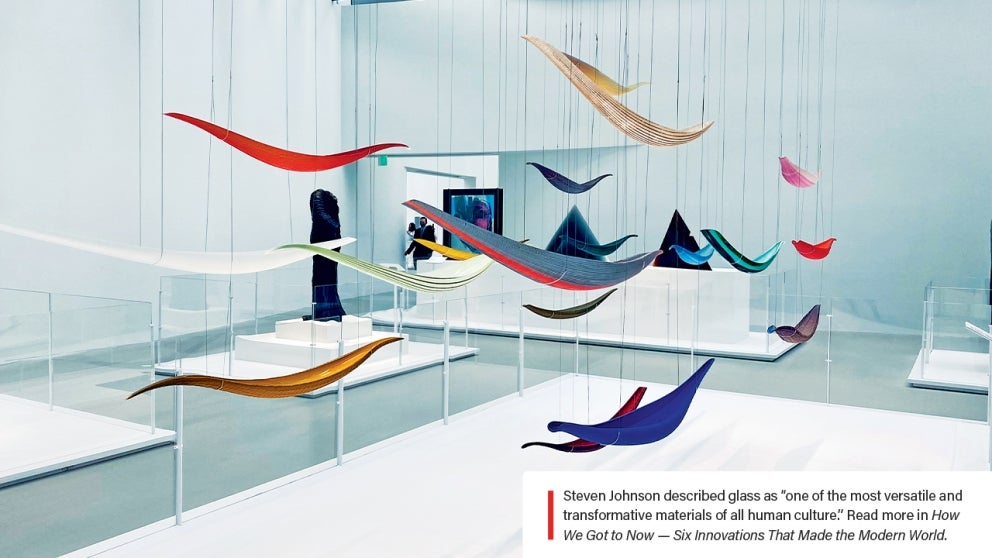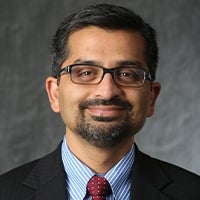
Raise a Glass … to Glass
Untangling the mysteries of this amazing material.

I was in seventh grade when I figured out how to pry open the back of a light bulb with a flathead screwdriver and remove the filament, the wires, and the stem, leaving me with a round glass bulb with its metal base. Filled with colored liquids, it looked beautiful, and with water, the bulb turned into a powerful lens. I would hold it near a wall, adjust the distance, and watch the projected images of cars zooming by on the busy street in front of our home or people walking hurriedly to their work, upside down, of course! That was the first time I thought about glass.
It was only in grad school that glass entered my consciousness more seriously in an advanced thermodynamics class. I learned that glass, although solid, is really a quenched liquid, and that distinction is important for much of what makes glass, glass. Molecules in a liquid move about freely with no long-range order. As a liquid is cooled, a sharp transition occurs at the freezing point, where molecules organize themselves into a solid crystalline state — think hexagonal ice with all its symmetries and beauty. In contrast, glass is formed when a liquid is quenched so rapidly that molecules do not get a chance to find the optimal ordered crystal state. It is as if the thermometer yells “red light!” to the liquid molecules and everyone freezes in place.
The history of glass making dates back to at least 3600 BC, with periods of tremendous innovations between then and now. The story of how glass went from ornaments to advanced technology — from beads to windows to shimmering glass towers, from wine glasses to powerful lenses and optical fibers — is fascinating. You may enjoy Steven Johnson’s delightful and entertaining book, How We Got To Now — Six Innovations That Made the Modern World, in which he describes glass as “one of the most versatile and transformative materials in all of human culture.”
Celebrated physicist Richard Feynman, in his Lectures on Physics, posed the following question: If, in some cataclysm, all scientific knowledge were to be destroyed, and only one sentence was passed on to the next generation, what would it be? Feynman’s answer was the atomic hypothesis, that everything is made of atoms, moving about, attracting each other when slightly apart, and repelling when squeezed together. Feynman said, “In that one sentence, you will see there is an enormous information about the world, if just little imagination and thinking are applied.”

At Rensselaer, a lot of imagination, thinking, and high-performance computing are being applied to understand glass. We know that glass breaks on strong impact. Glass can also get tired and break after a long time under a static or cyclic mechanical load or in the presence of water or water vapor. Professors Liping Huang, Minoru Tomozawa, and Yunfeng Shi in the Department of Materials Science and Engineering are advancing fundamental knowledge of how a crack initiates and propagates in glass through laboratory experiments and large-scale atomic simulations (i.e., molecular scale movies) on supercomputers in the Center for Computational Innovations to understand how a crack develops in glass at the microscopic scale, so we can make glass tougher and stronger.
As COVID-19 spread throughout the U.S. and the world last year, universities faced a serious challenge. I am proud of how quickly our faculty, staff, and students transitioned to online and hybrid learning. We developed innovative pedagogies, and imagined and implemented new ways to engage students, to assess them, and to provide them meaningful laboratory experiences. As professors delivered lectures behind Plexiglass shields to hybrid classrooms, glass lenses of cameras recorded them. Images were passed at high speeds over fiber optic cables to students from California to China, who in turn watched them on the glass screens of their computers, I could not help but marvel at the role of this invisible material that made it possible.
With the inventions of the microprocessor, the digital camera, and the graphics processor, Rensselaer alumni helped launch the digital or silicon revolution over the past many decades. Kurt Van Wagenen ’85, president and CEO at FirstLight, a fiber-optics communication and data company, or Thomas G. Capek ’86, senior vice president and chief engineer at Corning, might tell you that we are entering another Silicon Age, the age of glass. The UN has designated 2022 as the International Year of Glass. I will begin the celebrations by raising a glass to this amazing material. Will you join me?















